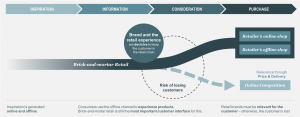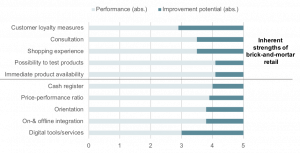Digital competitors have transformed the traditional retail business and exerted extreme pressure on brick-and-mortar retailers who seem to have lost the connection to their customers. For the latter, it is more than ever essential to understand customer needs and to rethink their current business strategy in order to revive their business. Vivaldi has identified key levers how the brick-and-mortar retail can reinvent itself.
Pure players have been opening brick-and-mortar retail stores all over the world. Even online giants like Amazon and Alibaba who have transformed traditional retailing are acknowledging the utmost importance of brick-and-mortar stores. Why is brick-and-mortar retail so important for online players? To keep it simple: Consumers still want to receive their products immediately and want to feel and test them before purchasing, and the online players know that, because they know their customers. Brick-and-mortar retailers, on the other hand, have been focusing on trying to reach their customers online, but as a result, they are neglecting their brick-and-mortar business. Do brick-and-mortar retailers underestimate their unique direct connection to customers, or do they simply not understand customers’ desires? In any case, they are losing touch with customers, while online players strengthen their bonds with customers.
Intrigued by this paradox, Vivaldi conducted a study on Consumer Centricity at the Point of Sale (POS). Consumer centricity means putting the customer into the spotlight by aligning the business with consumer needs. After conducting a multitude of consumer interviews spanning over several industries, including consumer electronics, fashion, beauty, and others, the main message is clearly revealed:
Brick-and-mortar retailers do not take advantage of their huge potential to create strong tangible brands that generate customer loyalty.
Instead of desperately trying to defeat pure players on their battlefield, brick-and-mortar retailers should take advantage of their function as a customer interface. They have to understand that in most cases, the customer journey begins in the real environment. The first touch point and first brand contact happens in brick-and-mortar retail stores. It is at these points where retailers have to create strong, memorable and positive brand experiences.
If this does not happen and customers decide to turn to online shopping instead, brick-and-mortar retailers will lose the fight for customers, as the online channel takes competition to another level. There will not only be more players in the game, but also players who are native to the environment and have extensive e-commerce experience, thus enjoying an competitive advantage. The ultimate winners will be players who can offer consumers better and cheaper products and services. Therefore, price and delivery conditions are decisive success factors when competing for customers online.
To avoid intense online competition, brick-and-mortar retailers must gain a deep customer understanding and use these insights to develop a customer-centric POS strategy. Customers will only consider shopping with a brand online if they are satisfied with the brand’s offline experience. Therefore, brand building and establishing customer loyalty start in brick-and-mortar stores.
Figure 1: The Brand’s Role in the Customer Journey

The Vivaldi study revealed huge gaps between customer desires and the actual performance of brick-and-mortar stores. To be specific, brick-and-mortar retailers have not yet adapted to the changing needs of customers. To survive in the new world of retail, brick-and-mortar retailers must acknowledge that the old way of doing business has become obsolete. Brick-and-mortar retailers must reinvent themselves to be customer centric.
Here are the four imperatives for retail reinvention:
1. Understand your role – brick-and-mortar retailers must be more than a mere point of purchase
Retailers must think outside the box to improve their customer’s shopping experience. On one hand, this could be achieved by improving the POS presentation and moving from a functional store design to a more emotional one, using methods that address multiple senses (sight, hearing, touch, taste, smell, and/or vestibular). To do so, retailers must understand consumer desires and shopping habits. Do consumers want to extend their shopping activities and prefer more interactions with the product? Brick-and-mortar retailers can use this insight as an opportunity to create a new POS experience. For example, for electronic retailers, this could suggest providing a “games corner” where consumers not only try out games but also come into contact with other likeminded gamers who may have product recommendations.
Thinking even further, the understanding of shopping habits could also be used for extending current business models. Consumers often enjoy shopping offline due to the interaction with other human beings or the convenience of linking their shopping trips with other activities, such as going out for a meal. Brick-and-mortar retailers can exploit this insight by extending their business model or forming new partnerships. For example, IKEA, a Swedish furniture retailer with stores located worldwide, has identified an additional revenue source by adding a restaurant selling Swedish meals in each of its stores. In Germany, consumers were so welcoming of this concept that Germany IKEA was ranked the eighth most successful catering chain in terms of revenue after Subway!
2. Intensify strengths – brick-and-mortar retailers must exploit their inherent strengths
Brick-and-mortar retailers must realize and focus on their inherent strengths. Direct customer contact is their most important lever and competitive advantage against the online platforms. Therefore, employees are the most valuable assets. It is critical to establish a customer-centric mindset and to put the customer first – even before revenues. The aim must be to make every interaction of the customer with the brand as memorable as possible. Only when this is achieved, will customer loyalty increase.
Figure 2: Improvement Potential for brick-and-mortar Retailers

Brick-and-mortar retailers must pick up their pace as online giants like Alibaba and Amazon already realize the importance of physical customer contact and immediate product availability. For example, Amazon just recently opened its first “4-star-store” in New York City, where only products with a 4-star customer rating on amazon.com are sold. Customers also get the chance to see, touch, and interact with the products in real life and get to purchase and take them home instantly.
3. Use technological progress – brick-and-mortar retailers must integrate digital tools
Brick-and-mortar retailers have to unlock the opportunities that technological advancements provide. Nowadays, very few retailers follow a persistent integration of digital helpers such as apps, virtual reality, augmented reality, or artificial intelligence. Most brick-and-mortar retailers are stuck in time and restrain themselves out of fear of the unknown.
Looking at China, for example, it is evident how much potential lies in the integration of digital helpers. Alibaba’s newest Fashion Store in Hong Kong, “Fashion AI”, combines the best of the online and offline shopping experience. Digital displays recommend outfits, digital supporters assist customers with in-store orientation and prepare the dressing room for the customers along with in-store employees. During the fitting, customers can even see alternative colors of their chosen items or matching accessories in the mirrors. With one click, customers can ask for these additional items to be sent to their dressing room. To enable this individualized shopping experience, customers check in with their smartphones when entering the store. This data-driven journey does not end after customers leave the store. Customers can, for example, go on their phones and review the outfits they did not purchase. They can then share images of these outfits with friends and family who were not a part of the physical store experience, and decide if they want to return to the store or purchase the outfit online.
4. Let one plus one be three – brick-and-mortar retailers must build an interface between their online and offline channels
According to the Vivaldi study, consumers generally think that most of the studied retailers do an adequate job in their attempts to integrate their offline and online channels. However, it became obvious that they do not derive any added value from the current integration. As the customer journey is no longer straightforward, but rather complicated with many unforeseen variables, retailers nowadays face a high risk of losing their customers at some stage in the customer journey. Merely providing customers the option to purchase products both offline and online is not enough, especially since customers who do not instantly purchase at brick-and-mortar stores have to be actively directed to the retailer’s online shop. Hence, retailers have to reassess their customer retention actions. Is the current design effective in supporting customers in their channel transition? Are there any incentives at the POS that direct indecisive customers to the retailer’s online shop?
Amazon and Alibaba take on a pioneer role in this field. They know their customers and use that knowledge to build customer loyalty not only online but also offline. By combining the best of two worlds, they have created a seamless experience for consumers. It is evident that Amazon and other industry leaders will not stop here. Thus, the motto for brick-and-mortar retailers must be “now or never”.
